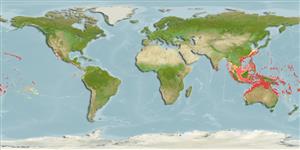Common names from other countries
>
Eupercaria/misc (Various families in series Eupercaria) >
Labridae (Wrasses) > Cheilininae
Etymology: Oxycheilinus: Greek, oxys = sharp + Greek, cheilos = lip.
Issue
Genus B. Mundy, pers. comm.
Environment: milieu / climate zone / depth range / distribution range
Écologie
marin récifal; profondeur 0 - 160 m (Ref. 1602). Tropical; 30°N - 30°S
Eastern Indian Ocean and Pacific Ocean: Christmas Island in the eastern Indian Ocean to the Hawaiian, Marquesas and Tuamoto islands, north to the Ryukyu Islands, south to Rowley Shoals in northwestern Australia, New Caledonia, and Rapa.
Taille / Poids / Âge
Maturity: Lm ? range ? - ? cm
Max length : 46.0 cm TL mâle / non sexé; (Ref. 2334); poids max. publié: 1.4 kg (Ref. 2334)
Épines dorsales (Total) : 9; Rayons mous dorsaux (Total) : 10; Épines anales: 3; Rayons mous anaux: 8 - 11. Adults developing a distinctive black blotch covering the rears of the dorsal and anal fins (Ref. 37816). Display a bright white band over the tail (Ref. 48636). White bar often present on caudal peduncle (this pattern very changeable). Red lines radiating posteriorly from eye continuous across opercle to posterior opercular edge. Membranes of spinous portion of dorsal fin smooth, not incised (Ref 9823).
Usually solitary in coral rich areas of clear lagoon and seaward reefs. Hovers well above the bottom (Ref. 9710, 48636). Young secretive in soft corals and hydrozoans (Ref. 48636). Benthopelagic (Ref. 58302). Feeds mainly on fishes, shrimps and other crustaceans (Ref. 9823). May be ciguatoxic (Ref. 37816). Minimum depth reported taken from Ref. 128797.
Life cycle and mating behavior
Maturities | Reproduction | Spawnings | Egg(s) | Fecundities | Larves
Oviparous, distinct pairing during breeding (Ref. 205).
Westneat, M.W., 1993. Phylogenetic relationships of the tribe Cheilinini (Labridae: Perciformes). Bull. Mar. Sci. 52(1):351-394. (Ref. 7441)
Statut dans la liste rouge de l'IUCN (Ref. 130435)
CITES (Ref. 128078)
Not Evaluated
Menace pour l'homme
Reports of ciguatera poisoning (Ref. 4887)
Utilisations par l'homme
Pêcheries: intérêt commercial mineur; Aquarium: Commercial
Outils
Articles particuliers
Télécharger en XML
Sources Internet
Estimates based on models
Preferred temperature (Ref.
115969): 23.6 - 28.9, mean 27.3 (based on 690 cells).
Phylogenetic diversity index (Ref.
82804): PD
50 = 0.5020 [Uniqueness, from 0.5 = low to 2.0 = high].
Bayesian length-weight: a=0.01585 (0.00707 - 0.03555), b=2.95 (2.76 - 3.14), in cm Total Length, based on LWR estimates for this (Sub)family-body shape (Ref.
93245).
Niveau trophique (Ref.
69278): 4.1 ±0.70 se; based on food items.
Résilience (Ref.
120179): Milieu, temps minimum de doublement de population : 1,4 à 4,4 années (Preliminary K or Fecundity.).
Fishing Vulnerability (Ref.
59153): Moderate vulnerability (36 of 100).
